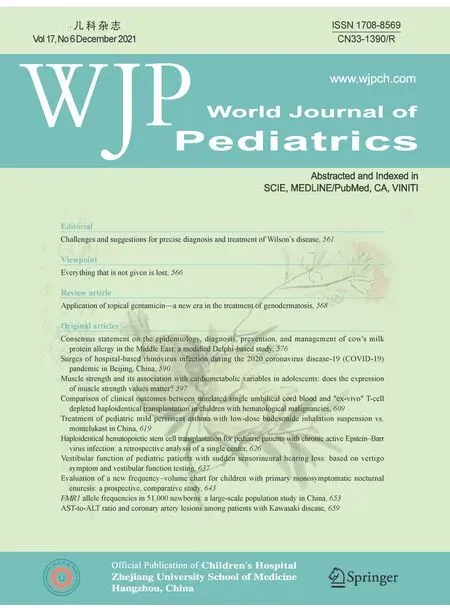Circulating immunocompetent cell profiles during oral cyclosporin therapy for immunoglobulin-resistant Kawasaki disease
eigo Okada · Yuji Ohnishi · Takashi Furuta · Yasuo Suzuki · Akiko Kawakami-Miyake · Chie Matsuguma ·Takako Waniishi · Hiroki Yasudo · Shunji Hasegawa
Although the standard treatment for Kawasaki disease (KD)is intravenous immunoglobulin (IVIG) combined with oral aspirin, 18% of 1st IVIG is refractory [ 1]. Recently, the efficacy of immunomodulatory drugs for IVIG-resistant KD,such as prednisolone, infliximab (IFX), and cyclosporine(CsA), has been reported [ 2- 5]. However, optimal immunomodulatory therapy for IVIG-resistant KD has not yet been established.
In this study, we evaluated the immunomodulatory effects of oral CsA (n= 6) compared with IFX (n= 51)(control group, which has different and specific therapeutic targets) for IVIG-resistant KD (Supplementary Fig. 1). All patients were administered two cycles of IVIG (2 g/kg/dose)before treatment. The kinetics of peripheral blood mononuclear cells (PBMCs) were assessed by flow cytometry according to a previous study [ 6]. Coronary artery lesions were defined as aZscore of coronary diameters ≥ + 2.5,measured by two-dimensional echocardiography 1 month after onset [ 1, 7]. CsA administration was started on day 9 (9-21) at a dose of 4 mg/kg/day and continued for 11(7-14) days (Supplementary Table 1). All patients showed complete defervescence after CsA therapy. In the control group, patients received IFX at a dose of 5 mg/kg on day 8 (4-15). There were no significant differences in the side effects between the groups. The absolute number of CD8 + HLA-DR + cells, but not other PBMCs, significantly decreased after CsA therapy (P= 0.047) (Fig. 1). In the control group, the absolute number of CD14 + monocytes decreased after IFX therapy (P= 0.031). The absolute numbers of total CD4 + , CD8 + , CD4 + HLA-DR + , and CD8 + HLA-DR + cells significantly increased after IFX therapy (allP≤ 0.001).
T cells are suppressed during the acute phase and are ameliorated after IVIG or the convalescent phase [ 8, 9].However, IVIG-resistant KD patients show T cell activation even during the acute phase [ 9, 10]. Therefore, CsA may be a useful option in this population, especially with CD8 + T cell activation. Based on the results in which different kinetics in PBMCs were observed according to the therapies,different immune mechanisms affecting the efficacy of the drugs might be involved in immunoglobulin-resistant KD.There are some limitations to our study that might lead to biased results, such as a small number of participants and an age effect on the T cell population. Nevertheless, this study provides new insights into immunomodulatory therapy for KD. Further multicenter and long-term studies are required to explore the immunosuppressive mechanism of CsA in patients with KD.

Fig. 1 The kinetics of immunocompetent cells in addition to laboratory data before and after CsA therapy. Absolute number of immunocompetent cells ( a- h)and serum levels of C-reactive protein ( i) and soluble interleukin-2 receptors ( j) before and after CsA therapy in children with Kawasaki disease. Control group shows those before and after IFX therapy. Box plots indicate ranges, IQRs (25th-75th percentile), and medians.Dot plots indicate outliers. The dotted area indicates the IQRs of 18 healthy control children(data referred from the reference 6). CsA cyclosporine A, HLA human leukocyte antigen, IFX infliximab, IQR interquartile range
Supplementary Information The online version contains supplementary material available at https:// doi. org/ 10. 1007/ s12519- 021- 00468-3.
Acknowledgements The authors also thank all other members of our affiliations for supporting patient care.
Author contributions OS contributed to conception, design, acquisition, analysis, and interpretation of data, and drafting the article. OY,FT, SY, KMA, and MC contributed to acquisition, analysis, and interpretation of data. WT contributed to analysis of data. YH contributed to analysis and interpretation of data. HS contributed to revising it critically for important intellectual content and final approval of the version to be published. All the authors approved the final version of the manuscript to be published.
Funding This work was supported in part by JSPS KAKENHI Grant Number JP19K08323 (H.S.) from the Ministry of Education, Culture,Sports.
Compliance with ethical standards
Ethical approval The study protocol was approved by the institutional review board (H28-159). Written informed consents were obtained from patients’ parents.
Conflict of interest No financial or non-financial benefits have been received or will be received from any party related directly or indirectly to the subject of this article. The authors have no conflict of interest to declare.
Data availability The datasets generated during and/or analysed during the current study are available from the corresponding author on reasonable request.
 World Journal of Pediatrics2021年6期
World Journal of Pediatrics2021年6期
- World Journal of Pediatrics的其它文章
- Haploidentical hematopoietic stem cell transplantation for pediatric patients with chronic active Epstein-Barr virus infection:a retrospective analysis of a single center
- Treatment of pediatric mild persistent asthma with low-dose budesonide inhalation suspension vs. montelukast in China
- Comparison of clinical outcomes between unrelated single umbilical cord blood and “ex-vivo” T-cell depleted haploidentical transplantation in children with hematological malignancies
- Muscle strength and its association with cardiometabolic variables in adolescents: does the expression of muscle strength values matter?
- Consensus statement on the epidemiology, diagnosis, prevention,and management of cow's milk protein allergy in the Middle East:a modified Delphi-based study
- Evaluation of a new frequency-volume chart for children with primary monosymptomatic nocturnal enuresis: a prospective, comparative study
